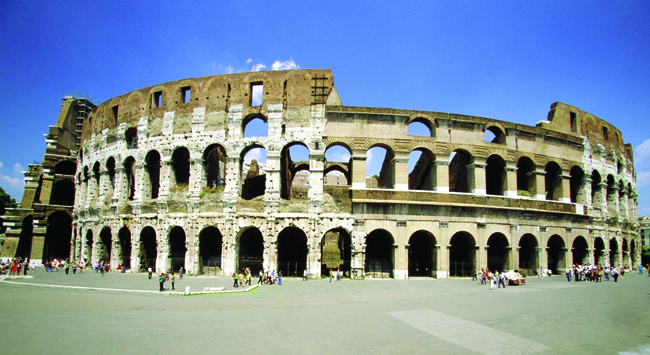Almost 2,000 years ago, Emperor Vespasiano built the Colosseo in Rome – a giant oval stadium capable of hosting over 50,000 spectators that still stands today.

No other monument says ‘Rome’ quite as much as this: the Colosseum, situated towards the south of the central area of the Eternal City (in the grounds of Nero’s Domus Aurea). Inaugurated in 80AD by Vespasiano’s son, Titus, with a series of games that lasted 100 days and nights – and which resulted in the deaths of over 5,000 animals – the Colosseum was originally known as the Flavian Amphitheatre. This was the least of the bloodshed, however, for Trajan once held games to celebrate victory over the Dacians, which lasted for a (quite literally) colossal 117 days and during which more than 9,000 gladiators fought to the death (a further 10,000 beasts were put to the sword during the combat).
Gladiatorial games originally started during the Etruscan period as a method of human sacrifice, though by 100BC they’d grown in popularity to a point where their origins were all but forgotten. Caesar himself exhibited 320 pairs of gladiators in 65BC, with the numbers swelling to the point where Augustus and Trajan were regularly displaying 5,000 pairs at a time. It’s amazing that the three-tiered structure is still standing… The exotic plants that made the Colosseum their home over several centuries should have toppled it: these were inadvertently brought in as seeds, carried by the animals forced to ‘compete’ at the games (though quite what defence a giraffe would have mustered against a collection of heavily armed gladiators one has to wonder…).
After this, during the Middle Ages, the structure was used as a fortress by a pair of Rome’s warrior families (the Frangipanis and the Annibaldis). And since then?Well, local seismic activity has done its bit, with the Colosseum damaged by earthquakes on several occasions. It has, of course, been subject to plenty of renovation work (which is currently ongoing), though one doubts that it will ever again attain the splendour as portrayed in a certain film from 2000 starring Russell Crowe. Speaking of which, the sequel is still in production, with the focus moving away from the games and further into the realms of the politics of early Rome, according to director Ridley Scott.
